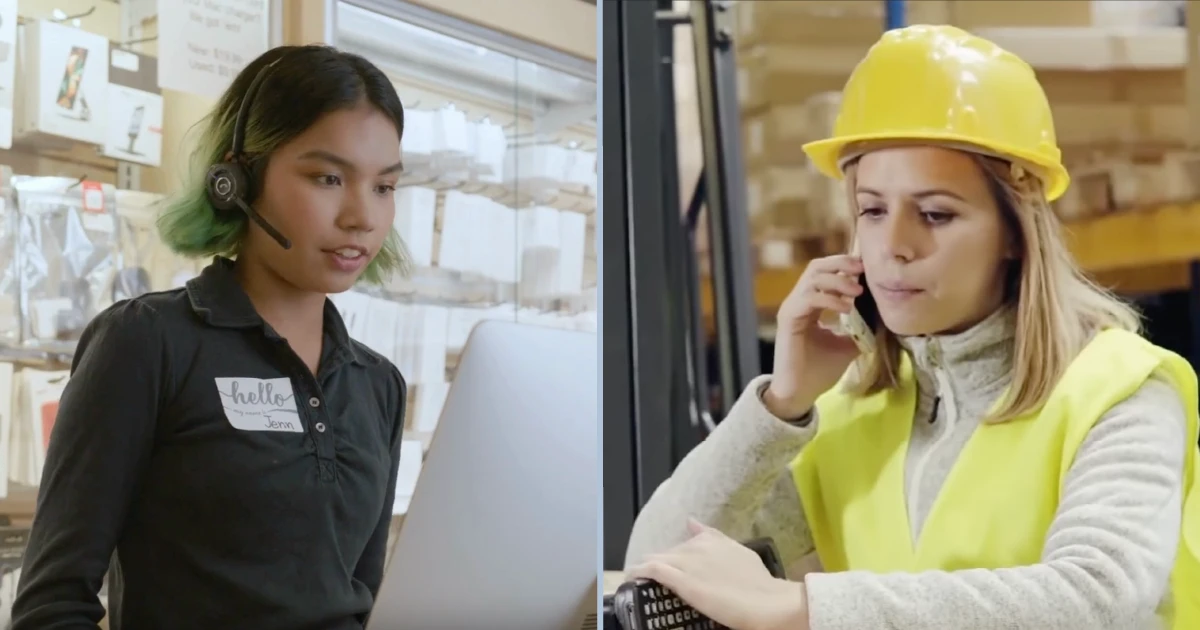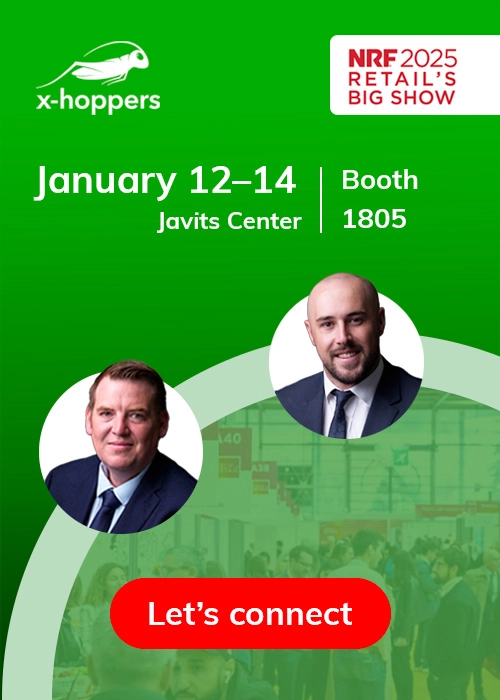
We’ve talked before about how real-time communication between associates can boost efficiency and create better in‑store experiences for employees and customers. But is it really enough?
If you have a chain of stores, you know that each store is not self-sufficient. They all need to coordinate with warehouses, distribution centers, call centers, other stores and headquarters to not only secure stock but serve customers and provide a consistent brand experience.
But reaching the person you need isn’t always easy. What’s meant to be a quick phone call can quickly snowball into a long, wasteful process. For example, let’s imagine a customer calls the call center wanting to know if their local store has a specific large product on display. The customer wants to see it before they buy it, and the nearest store is a 30‑minute drive, so it’s important they know ahead of time. The call center employee has no clue, so they put the customer on hold and call the store.
A desk phone rings for about five minutes before someone in the office picks up. They transfer the call to the relevant department’s handset, but it was picked up by a check‑out employee by mistake. There’s a long line of customers at checkout, so the stressed cashier apologizes but hangs up the call. Without a clear answer, the call center employee returns to the customer and tells them, unfortunately, they don’t know if the product is on display, and the only way to find out is to go to the store.
Now, the customer might follow through, or simply give up, delay the journey or go to a closer competitor instead. Either way, the risk of losing the sale is high and it could have easily been secured by reaching the right person the first time.
The solution?
AI-powered, voice-controlled phone systems that integrate directly with smart headsets. By switching to this kind of hands-free calling solution, in-store associates can save precious time and focus on what matters most: serving customers.
Retail communication challenges: Why desk phones don't work
Traditional desk phones and handsets weren’t designed for retail — but they’re not even holding sway with consumers. About 40% of Brits and barely a quarter of Americans currently own a landline, with most people relying exclusively on cellphones. This means that more and more, shoppers and employees live in a world where they can reach the people they want instantly, and their expectations from their home life carry over to retail.
But it’s not just meeting customer expectations that makes traditional phones frustrating; it’s the lack of flexibility. Desk phones are static, requiring staff to physically leave a customer to answer the phone. Handsets are a bit better, as you can carry them with you, but they are easily dropped or lost. And both are only truly useful for one-to-one calling, causing some employees to carry both handsets and radios to answer calls and coordinate with their team, physically weighing them down.
And then there’s the question of making calls. Who learns people’s numbers nowadays? That means that employees either need physical call lists or integrated digital address books to call the right person — and not all of them know how to use those tools. Plus, using them requires more time looking down at a paper or a screen and less time engaging with customers.
Finally, associates themselves are often frustrated by the lack of specifically designed frontline employee communication tools, contributing to employee disengagement and even high staff turnover rates.
So, for something that’s supposed to increase connectivity and collaboration, traditional phones actually contribute to:
- Reduced service quality
- Limited mobility for associates
- Workflow interruptions
- High staff turnover
- Increased costs due to lost sales and inefficiencies
If an employee were having the same negative impact on a store, you’d fire them. So why do we allow outdated systems to do this to our stores every single day?
Hands-free communication technology: How AI voice dialing works
Luckily, with the technology now available, there’s no need to rely on traditional phones or even mobile-based chat tools. Wearable and voice-based, retail headset solutions can now not only include telephony capabilities, but they also allow employees to handle calls hands-free thanks to AI assistance.
How does it work? Using a combination of natural language processing, automated workflows and agentic AI, AI‑powered retail headset solutions allow associates to verbally log in to their headsets, ensuring that the system knows who’s using the headset and what call groups or tags are assigned to that individual user. From there, that same employee can receive direct calls or pick them up from the broadcast by verbally accepting the call.
But it’s placing calls where the headset voice dialing technology really shines.
Since each user is logged into the system, an associate can just say the name of the individual or department they want to speak to anywhere in the business, like “call our local DC” and the system handles the rest.
AI assistant for new employee support
What if the employee is new and doesn’t know who to call? Well, the AI has them covered. Associates can simply ask the AI assistant who the best person to contact is and it will patch them through to the right person the first time. It can even help them troubleshoot technical issues, walking them through possible solutions step-by-step until there’s a roadblock, and then transferring them to the appropriate person. This way, even brand-new employees can get the support they need, whenever they need it. It also is able to reduce calls to over-taxed departments, such as IT or Maintenance, allowing them to focus and get systems back up and running faster.
Integration with existing phone systems
But the best part is that this type of system doesn’t need you to completely overhaul your entire telephony solution; it can integrate into what you already have, whether it’s a traditional PBX, VoIP platform or other cloud-based phone service. This can let you keep all the advantages of your current system and save you from a long rollout process.
Equally, some systems, like x‑hoppers, have telephony at their core, meaning you can integrate it or use it as your only call provider, consolidating your communications solutions and saving you money across the business.
Five key benefits for frontline operations
Now, we’ve covered how hands-free calling solutions work and what they can do, but what does it mean for your business? Generally, retailers that use a smart headset calling system see:
- Higher productivity thanks to less time wasted walking to phones, searching for the right number or waiting on call transfers.
- Improved customer satisfaction due to more available staff and faster responses.
- Faster staff onboarding thanks to an intuitive voice-first interface and access to knowledge on demand.
- Reduced staff turnover as a result of happier, more connected employees.
- Clear ROI from efficiency gains and higher customer satisfaction, which directly translates into cost savings and increased customer spend.
And this is all just from giving in-store associates access to in‑store communication and full telephony. Imagine what else you can accomplish by integrating the same solution with smart retail technology. Then you’ll not only have connected colleagues, you’ll benefit from the efficiencies gained from truly connected stores.
How to implement smart headset calling systems: A step‑by‑step guide
Like the idea of rolling out a smart headset calling system, but worried the process will be long and complex? Well, the good news is that it doesn’t have to be. All it takes is some careful consideration, planning and a good partner by your side to see your vision come to life.
Things you should consider:
-
Who do your associates need to call?
And who needs to reach them? Some retailers make their store numbers public; others funnel their calls through a call center. Specialty retailers will have associates who are more knowledgeable than most. Assess your staff and set up and decide if they all need full telephony or if internal calls are enough. Clearly establishing your needs before you settle on a provider will help you choose the solution that is ready to solve your issues, instead of picking one that might get there five years down the road. -
What goals do you want to set and how will you measure them?
With most providers, you’ll run a pilot before you commit to a full rollout. But to set yourself up for success, be clear from the start what you want to achieve and what metrics you’ll track. That way, not only will you know if the pilot is a success or not, you’ll know how to replicate that success across multiple sites. -
How will you train your staff?
Ideally, if you pick a provider that has agentic AI and natural language processing built in, your staff won't need to learn specific prompts or need much training. Still, it's a good idea to plan for training sessions that introduce your associates to the headsets, show how they work and explain practical use cases for their roles. Whether you choose to do this in‑person or through your e‑learning platform, don’t forget to set KPIs so you can track training completion and adoption rates. Because if your employees aren't on board, you won't see results. -
What maintenance will be required, and what's included?
When planning the implementation, don't forget to plan for what happens after rollout's complete. Will the vendor or an installation partner support you with any maintenance? Is it something that will be taken care of by your in‑house team? Make sure you're clear on who is responsible. Additionally, consider what you're already paying for, so you don't pay twice for a product or service. For example, some retail headset systems are sold as CAPEX, meaning that you pay for them once and they're yours. But that also means that lost or damaged headsets aren't covered, and you'll be charged each time one stops working. It also means that if you want the latest feature or integration, you'll probably need to upgrade the whole system.
However, if the system is sold as OPEX, that is to say, charged on a subscription plan, then it's worth taking a look at what's included. x‑hoppers, for example, replaces broken headsets, provides open APIs and ready-to-go integrations and includes technical updates and new features all as part of the subscription package.
Once you’ve mapped out your needs, goals and plan, the most important step is finding a solution that’s built to grow with you — and that’s where x‑hoppers comes in.
Complete retail communication: The x‑hoppers solution
Designed specifically for retail, x‑hoppers brings your in‑store communications, telephony and connected devices together in one smart, easy-to-use system. Instead of managing multiple devices or missing alerts buried in dashboards, your team gets the notifications and calls they need from one push‑to‑talk headset.
Here’s what that looks like in action:
- Built-in telephony with voice dialing. Associates can make and receive internal, external or inter-store calls using natural speech from anywhere in store.
- IoT and system integration. Connect smart shelves, sensors and other store systems so alerts are delivered instantly to the right associate, turning data into immediate action.
- Retail-specific features. From smart customer call points to AI‑assisted task management, x‑hoppers adapts to your unique in‑store workflows.
- Scalable and simple deployment. Designed to roll out easily across single stores or entire retail estates, x‑hoppers can get your stores talking in no time.
With hands-free telephony, AI‑powered communication and ready-to-go integrations, x‑hoppers turns retail headsets into frontline productivity tools that connect every person and every system in your store, helping you provide consistent, outstanding in‑store experiences.
Conclusion
The days of static phones and missed calls are over. Today’s retail teams need tools that move as fast as they do.
Hands-free calling solutions, like x‑hoppers, are no longer the future; they are here now. And thanks to the instant access they give associates to people, systems and insights, why stick with traditional phones, radios or even disconnected headset solutions?
Because smarter stores start with smarter communication — and it starts here.
Ready to make every call count? Speak to our team to discover how today.



